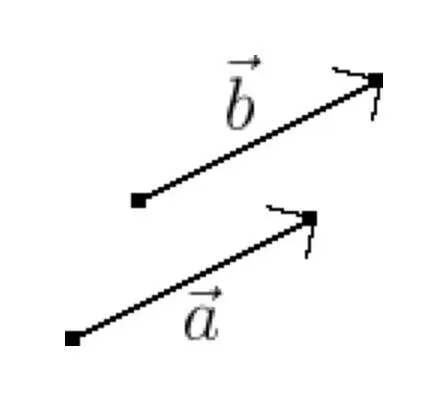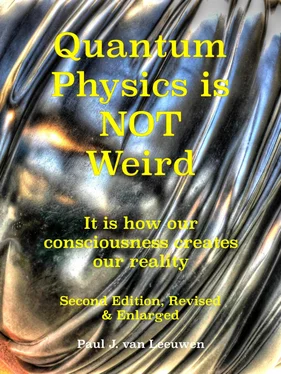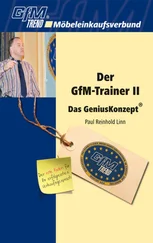Heisenberg’s quantum matrix mechanics is, as already mentioned, mathematically complex and only gives you discrete outcomes, the predictions about the observed aspects of atomic phenomena. The Schrödinger equation is, at first sight, an entirely different beast. Its solution is a continuous wave. It made quantum physics calculations considerably easier for physicists proficient in wave mechanics. That is the reason why most physicists preferred the Schrödinger equation, much to the chagrin of Heisenberg. Contrary to Heisenberg’s matrix mechanics the solution of the Schrödinger equation – the state function – describes an in space and time continuous phenomenon, a wave. But it was not clear what the substance would be in which it was propagating. If it really was a substance.
With his equation Schrödinger had hoped to save the classic causality and continuity of the Newton universe. He initially believed that the solution of his equation, the state wave, represented the materially spatial "spread-out" charge and mass of the electron. Ultimately, however, it was shown that the Heisenberg matrix mechanics and the Schrödinger equation are mathematically equivalent and – more importantly – that the quantum wave is a physical wave but nota material wave. By the term ‘material’ I mean something that is in principle directly ‘tangible’, whereby ‘tangible’ also includes the use of material instruments. By the term ‘physical’ I mean something having a physical effect, which is not necessarily material.
Consider for a moment here the fact that atomic objects have both wave and particle properties, and that this duality finds a counterpart in those two seemingly different quantum theories of Heisenberg and Schrödinger. Heisenberg is about discrete states, the particle aspect, Schrödinger is about waves. However, they have been shown to be equivalent.
The controversy between Heisenberg and Schrödinger continued to simmer somewhat throughout their related lives and careers. Schrödinger finally had to abandon his opinion about the materiality of the state wave and thus his hope that it existed in the material universe. He ultimately left the quantum physics community and changed the direction of his interest to the study of living systems.
The uncertainty relationship gave rise to heated discussions and worrying sleepless through the night. Heisenberg initially thought that his uncertainty relation was the result of the inherent limitations of physical measuring instruments. But it turned out to be a fundamental aspect of nature and of quantum physics. His uncertainty relationship can even be derived mathematically from the Schrödinger equation. In this way these two gentlemen and their two theories are reunited in an uneasy duality.
In 1927 Max Born(1882-1970) proposed a (meta)physical interpretation of the quantum state wave representing the solution of the Schrödinger equation. To understand his interpretation, let’s first have a better look at the character of the solution of Schrödinger’s equation. The solution of the equation is a time- and location dependent complex
state vector. The term complex means that the vector is defined by the combination of two terms of a different nature. The first term represents a real number, the second term is an imaginary [ 6 ]number. An imaginary number is a number that when squared gives you a negative result. It does not have a ‘tangible’ value.
 A vector [ 7 ]is a mathematical object with two properties: length and direction. Force and speed, having both spacelike and numerical properties, are rather straightforward examples of vectors in physics. A vector in a diagram is usually represented by an arrow and in a text by a line or arrow above or below the symbol.
A vector [ 7 ]is a mathematical object with two properties: length and direction. Force and speed, having both spacelike and numerical properties, are rather straightforward examples of vectors in physics. A vector in a diagram is usually represented by an arrow and in a text by a line or arrow above or below the symbol.
According to Born, the squared value of the length of the complex state vector, which is a real number, should be interpreted as the measure of the probability of finding the quantum object at a certain place and time. The length of the state vector at a certain location therefore directly represents the probability of finding the particle at that location.
It is interesting to try to see how Born may have come to his insight. His specialty was optics and then the question about light as a wave and light as a particle is an obvious concern. He must have been very familiar with semi-transparent mirrors (beamsplitters) that transmit half of the incident light and reflect the other half. He knew very well that Planck and Einstein had found that light is quantized in photons with a fixed amount of energy per photon.
Born must then have realized, combining these two facts, that the photons that reach the mirror must in their entiretyeither pass the mirror or be reflected. These photons are certainly not split in two halves. Such a split would mean a halving of their energy and therefore – according to Planck’s law – of their frequency and thus a doubling of wavelength. Which means a changing of the color of the light from, for example, violet to red. That is certainly not what is observed in beamsplitters. The probability for a photon of being reflected by an accurate beamsplitter is 50%. Born very probably mused on the meaning of the state vector of the Schrödinger wave function describing the process of a photon hitting a beamsplitter.
The value of the state vector describing the passage through the mirror therefore had to be connected, according to Born, with the probability to find the photon behind the beamsplitter. Because it concerns a probability, the outcome, whether it goes through the mirror or not, cannot be predicted for a single photon. Considering the huge numbers of photons that are sent through a beamsplitter in the average laboratory experiment, these numbers always average out, which accounts for the observed behavior of beamsplitters and other optical instruments.
The quantum uncertainty whether a single photon will pass through the semi-transparent mirror or not, is fundamental and is not the result of insufficient information concerning the photon and the mirror. Quantum probability is known by physicists as objective probability. Random generators using photons and beamsplitters – passing is 1, reflection is 0 – are generally accepted to produce fully reliable random binary numbers, bits.
So, according to Born, the objective probability that a particle is found at a certain time and place in a measurement is determined by the square of the amplitude – the length of the arrow – of the quantum wave function vector. The outcome is a natural number between 0 and 1 corresponding with a probability between 0% and 100%. Time and time again Born’s insight has proved to be excellently predictive in quantum experiments. Which is the way good scientific theories are confirmed. But why should an extra adjective – ‘objective’ – be assigned to quantum probability?
Конец ознакомительного фрагмента.
Текст предоставлен ООО «ЛитРес».
Прочитайте эту книгу целиком, купив полную легальную версию на ЛитРес.
Безопасно оплатить книгу можно банковской картой Visa, MasterCard, Maestro, со счета мобильного телефона, с платежного терминала, в салоне МТС или Связной, через PayPal, WebMoney, Яндекс.Деньги, QIWI Кошелек, бонусными картами или другим удобным Вам способом.

 A vector [ 7 ]is a mathematical object with two properties: length and direction. Force and speed, having both spacelike and numerical properties, are rather straightforward examples of vectors in physics. A vector in a diagram is usually represented by an arrow and in a text by a line or arrow above or below the symbol.
A vector [ 7 ]is a mathematical object with two properties: length and direction. Force and speed, having both spacelike and numerical properties, are rather straightforward examples of vectors in physics. A vector in a diagram is usually represented by an arrow and in a text by a line or arrow above or below the symbol.










